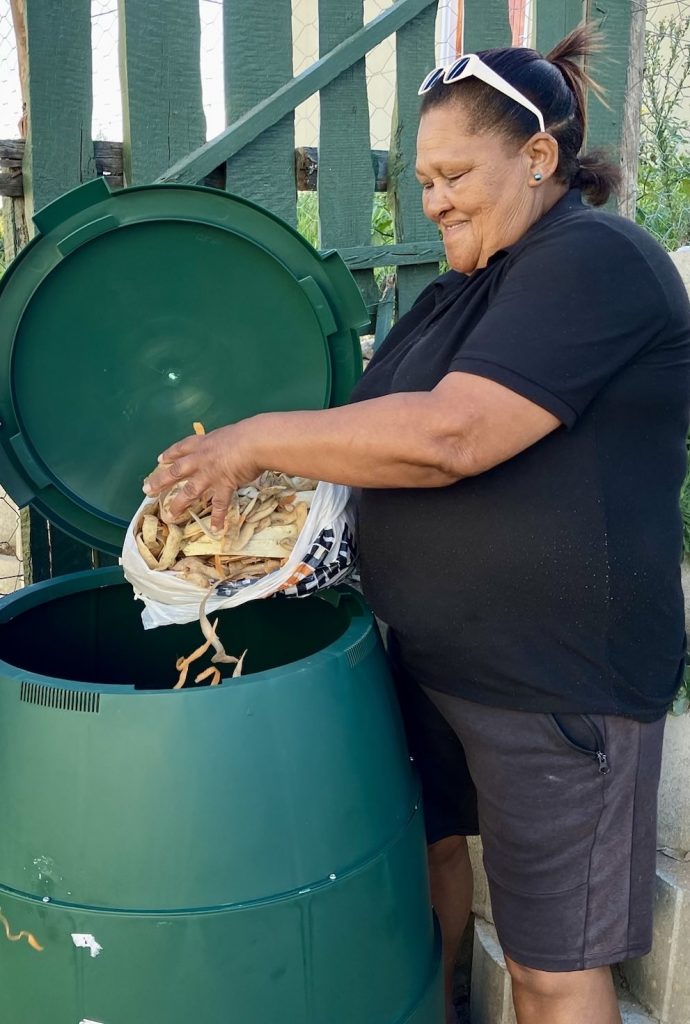

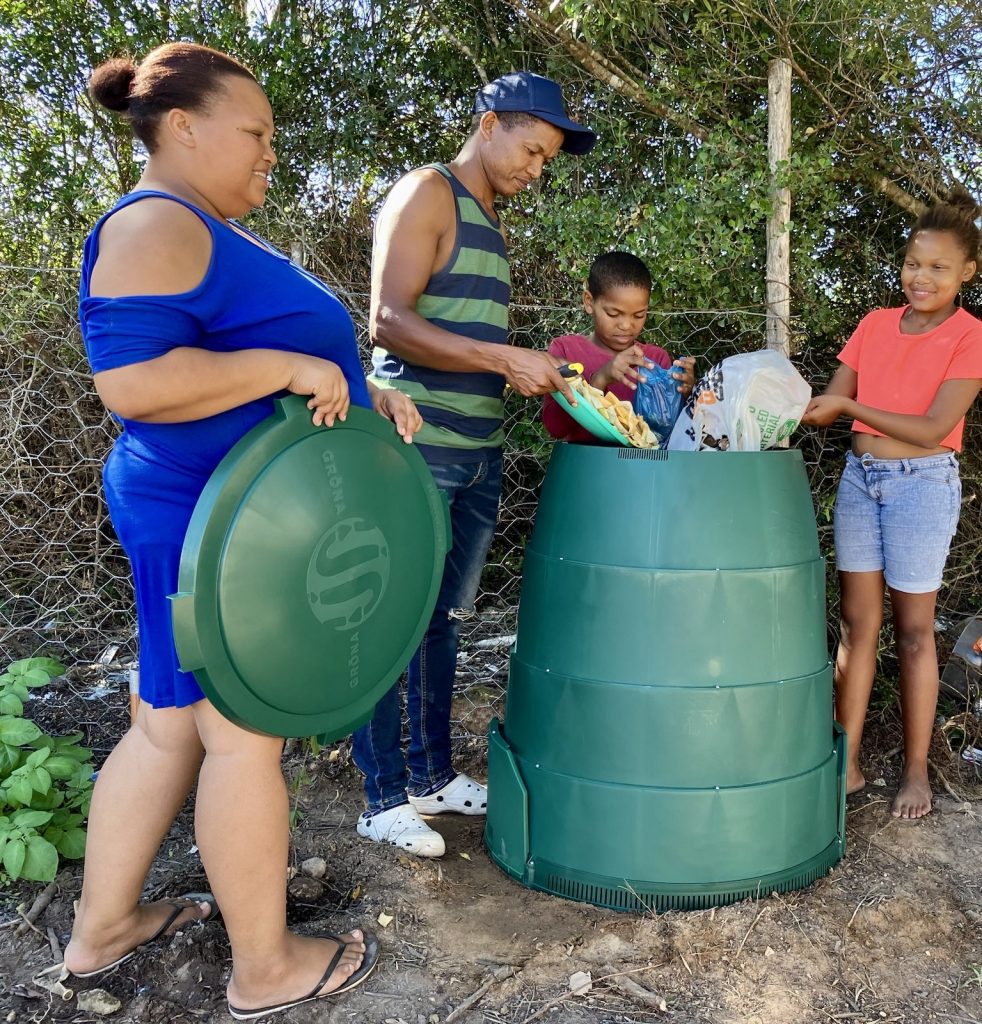
The Green Johanna is a top-performing composter that recycles and turns food waste – including cooked food, meat and fish – plus cardboard, paper and garden waste into high quality compost.
Made in the UK from 100% recycled plastic, they have a minimum expected lifespan of 10 years. In South Africa the first Green Johannas were installed in 2010 and are still working today. The unit is recommended as a ‘Best Buy’ by the BBC Gardeners’ World magazine. You can find out more about our project making the Green Johanna available in the wider Stilbaai area here.
The Green Johanna is an enclosed unit with a perforated integrated base plate that allows access to worms and micro-organisms while deterring vermin and animals. It has a patented design and airflow system, and a secure twistable lid helping to regulate ventilation. Food and garden waste is placed into the top of the unit, breaking down into compost which is removed from the 2 doors at the bottom. It is therefore a continual process. From our experience of working with the units in South Africa, you can expect your first compost within 4-6 months.

The Green Johanna is best placed on a flat patch of grass or soil to enable access to worms, insects and other micro-organisms that are important in turning the waste into compost. Placing the unit on grass or soil also means any liquid produced can drain away freely. In South Africa the unit would ideally be placed in semi-shade. Avoid placing it in areas which become waterlogged e.g. in close proximity to rainwater down pipes.
The units are easy to assemble and consist of an enclosed base plate and four modular sections that screw together – it is important that these sections are installed correctly to ensure the system works. In addition there are two access doors and a lid. Green Johannas are supplied with all the required fittings and Dreamcatcher enterprises will install the units and explain how the units work.
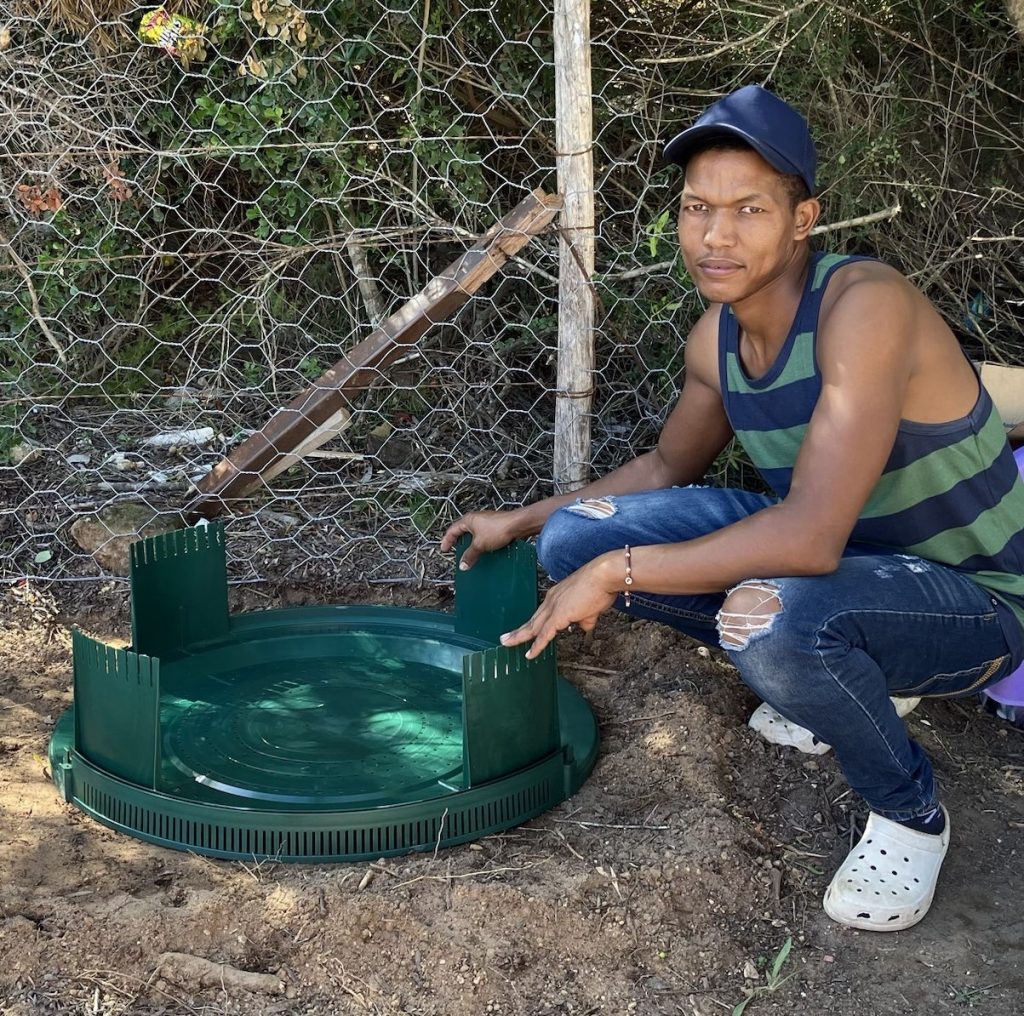


Create a base layer approximately 15cm deep in the bottom of the Green Johanna of sticks or stalks and some torn up cardboard. This helps to create airflow through the unit. Some sticks may still be intact when you come to take compost out of the bottom of the Johanna. They act as breathers, just put the stick which have not broken down back at the top.
Alternatively, you could use woodchips in this base layer. These break down faster making retrieving compost easier without having to remove the sticks. However NO treated wood can go into a Green Johanna, as the treatment will kill the microorganism which are needed for the Green Johanna to work 
Top this with some fine garden waste such as grass trimmings followed by a bucketful of soil to allow micro-organisms to jump-start the process.
Now you can start to add waste materials. During the first month, add only raw fruit and vegetable peelings as food waste, along with the carbon-rich materials (see below), to give the contents time to build up heat before adding cooked food waste such meat, fish and plate left overs.
The insects and micro-organisms digesting the waste need a diet providing them with nitrogen for growth and carbon for energy. For the Green Johanna to work optimally there needs to be the correct balance of materials:
Nitrogen-rich items (Greens) including:
Green garden waste:
Food waste:
Carbon-rich items (Browns) include:
Brown garden waste:
Other:
Egg shells – these are an excellent source of calcium. Rinse out the film with leftover dishwashing water – then crush or grind them to speed up decomposition
DO NOT add the following items/materials:
Caution:
Small bones can be added – but avoid large bones. If bones are added to the Johanna they will not break down and it would be necessary to remove stripped-down bones from the finished compost. The bones can be ground down (use a hammer) and used as a fertilizer. But care needs to be taken as bones can be a danger to dogs.
Pet bedding from vegetarian pets – for example from guinea pigs or rabbits. Under no circumstances should dog or cat faeces/litter be added.
Adding these waste items in a 50:50 ratio is a good place to start:
Stockpile materials: Most people find they usually have a ready supply of nitrogen-rich Greens but lack carbon-rich Browns. It can be useful to stockpile carbon sources before you need them, storing shredded twigs, autumn leaves, shredded cardboard etc in lidded containers so that they’re ready to be added each time you add nitrogen waste. Shredded paper is also an excellent source of carbon.
Cut up large items: The smaller the waste items are, the more surface area there is for microbes to work on. Decomposition will be faster and higher temperatures will be reached. Large food waste and garden waste should be chopped up (particularly woody material), paper and cardboard should be shredded or torn up. Scrunched up paper is a great thing to add as it acts as an air pocket in the Green Johanna helping with air circulation.
Avoid large amounts of the same material: If adding large amounts of grass cuttings, add them in thin layers balanced with carbon sources (such as twigs or shredded paper) so they don’t clump. Thick layers of cut grass will make a film and circulation of air is affected. Similarly if adding large amounts of sawdust, add them in thin layers balanced with nitrogen sources to avoid clumps.
Composting is a bit like making a cake: You will come to know if the balance is not right and can make adjustments depending on conditions in the Green Johanna. For example, if the contents become too wet, they will start to smell; this means you need to add more carbon and aerate well.
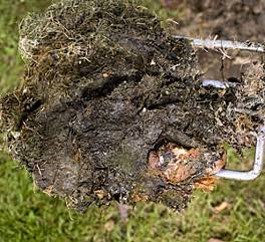
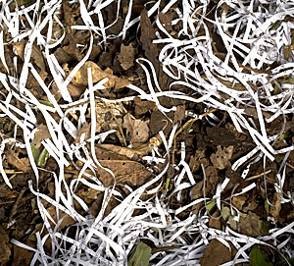

Its important to keep the unit aerated. Every so often give the contents a deeper stir by using a stick or garden fork to get air flowing throughout the bin. Take care not to mix new material with compost right at the bottom.
Compost is ready when it smells like earth when you open the lid, and when you open a door the bottom contents is a soil like consistency, dark brown in colour, and crumbly in texture. When you start out, the first batch of compost should be ready to use after 4-6 months. After that the hot composting process may take considerably less time, depending on the installation and time of year (i.e. summer or winter).
To access your compost, unscrew the hatches at the bottom of the Johanna and remove the compost using a garden hoe or a similar tool. Any materials that might not have fully broken down, such as fruit stones, nut shells, eggshells, teabags, twigs or sticks, can be removed and added to the Johanna again to continue the breakdown cycle. Modular sections mean that it’s possible to remove more compost by unscrewing sections if you wish.
Compost can be used to grow food and flowers. It can be dug into top 1-20cm of soil or spread over soil. The compost replenishes your garden with lost nutrients. Compost will also improve soil structure, texture, aeration and water retention in your garden.

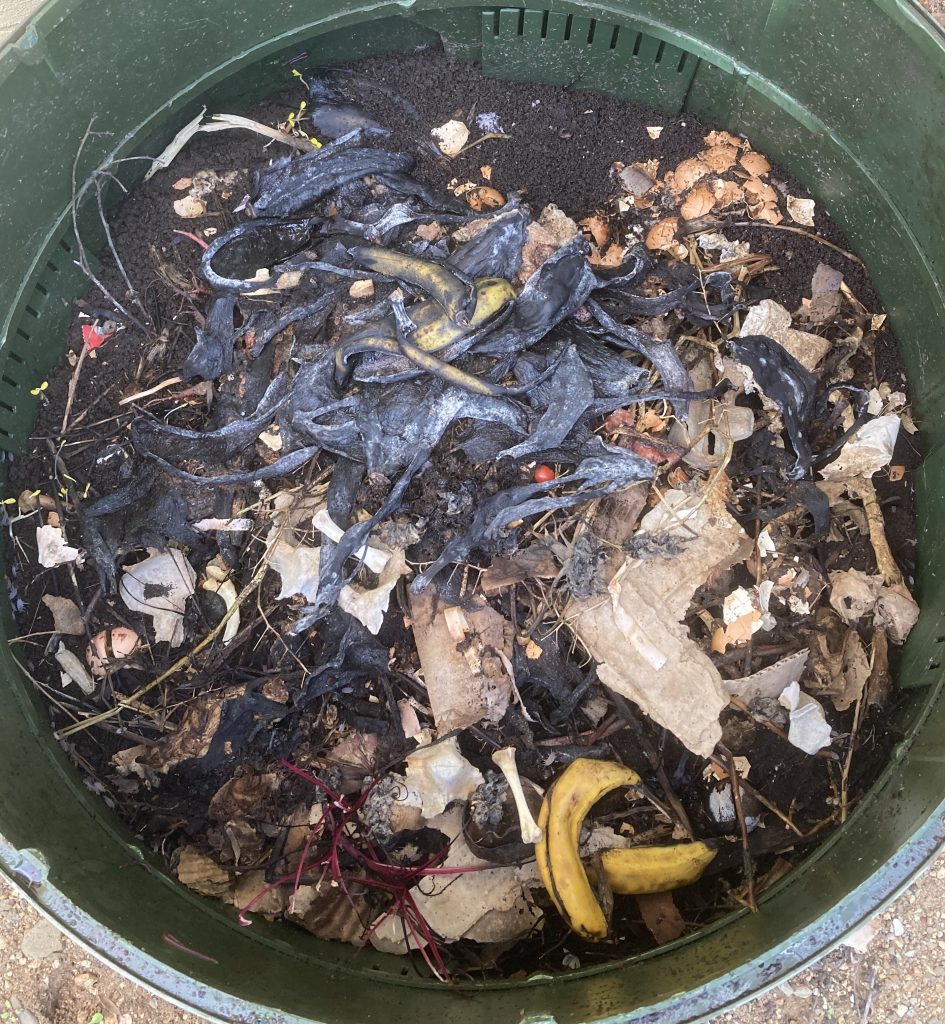

The Dreamcatcher team is here to support your queries (see below for contact details) – but here are some answers to ‘Frequently Asked Questions’. Click on the question to get your answer 😉
The Johanna is designed for a household of up to six people with garden waste clippings produced from an average garden. A garden produces less waste in winter, so if you have space you could store some waste to layer in with food waste during winter.
As micro-organisms break down waste and multiply, they generate heat. As the temperature in the compost fluctuates, the types of micro-organisms present also change. This diversity is important. How warm the compost gets depends on what you have put in together with levels of oxygen and moisture. Different micro-organisms work at different temperatures.
There are three major phases in successful composting – mesophilic/thermophilic/maturation.
The mesophilic phase occurs at the start when decomposition is carried out under moderate temperatures by mesophilic organisms. The thermophilic phase occurs as the temperature rises and various thermophilic (heat-creating) bacteria carry out decomposition at temperatures of 50-60 degrees Celsius. The maturation phase occurs when the temperature starts to decrease as the supply of high-energy compounds dwindles and mesophilic bacteria once again predominate.
Twigs, branches, dried leaves, sawdust, woodchips, paper, and cardboard.
Food waste, coffee grounds, fresh grass clippings, fresh green leaves.
The time required for waste materials to break down into compost depends on:
Depending on conditions, the usual time using the Green Johanna is 4 – 6 months (it may take slightly longer when the Green Johanna is being used for the first time).
There are several reasons for a composter to stop working:
Cold weather and a poorly-fed Green Johanna can bring a halt to the composting process. In winter make sure that you are adding content regularly.
A well functioning compost bin should hardly have an odour. Any smell should be fresh and earthy. You have probably added too much nitrogen-rich waste, such as grass clippings or food waste. Remedy this by adding plenty of carbon-rich garden waste (shredded twigs/branches/autumn leaves/wood chips), shredded or scrunched paper and cardboard. You also need to get oxygen into the mix by stirring well. You may need thoroughly aerate the compost deeper down by using a hoe or garden fork. Take a small batch of the finished compost or half-composted material from lower down the unit and sprinkle over the top.
If you have large amounts of fresh grass clippings (nitrogen-rich) this should not be added all at once and should be well balanced with carbon-rich materials such as shredded autumn leaves and newspaper.
You need to keep your compost moist; ants are attracted to dry, soil-like materials. Gently add water to your mix using a small watering can and stir in well. You want the consistency to feel as damp as a wrung-out bath sponge. If you squeezed a handful of compost between both hands only a drop or two of liquid should come out.
This is an indication of poorly covered, nitrogen-rich content. It is likely that the consistency is too wet. Add carbon-rich garden waste such as shredded twigs/branches/woodchips, shredded or scrunched paper and cardboard and mix in well. This will absorb some of the excess moisture and add air throughout the mix. Deter flies by adding a surface layer of soil or compost to the top of the bin’s contents. Also check that you are shutting the lid securely when filling up the composter.
Depending on the temperature and stage of decomposition there will be: worms, snails, beetles, woodlice, millipedes, centipedes, slugs and earwigs. There will also be a whole host of bacteria, micro-organisms and fungi that are invisible to the human eye.
In some other countries - such as Sweden and UK - its possible to get an insulation jacket for your Green Johanna. This is to help the Green Johanna work during the winter when temperatures are low. From our experience of testing the Green Johanna for over a decade, our research is that the insulation jacket is not needed in South Africa.
To reduce costs the units have not been supplied with aeration sticks - which are used to stir contents to help aerate the unit. A stick or a fork can be used to fulfil the same function.
From our experience no accelerator or activator is needed in South Africa due to the higher temperatures than in northern Europe where the units are commonly used.
No. We have a deep seated sense of responsibility to addressing the environmental and social impact of organic waste going to landfill. The drive for the Green Johanna initiative is to help address some of the critical waste challenges in the wider Stilbaai area whilst harnessing organic waste as a resource which is currently being wasted. Dreamcatcher is making no money from the sale of Green Johannas - and thanks to our supporters we are able to make them available for significantly less than what they retail for in the UK where they are manufactured.
If you want to reduce your organic waste going to landfill, produce high quality compost to use in your garden, help the environment and reduce emissions, and save costs on black rubbish bags to boot, contact us here today!
To order your Green Johanna please contact us on: